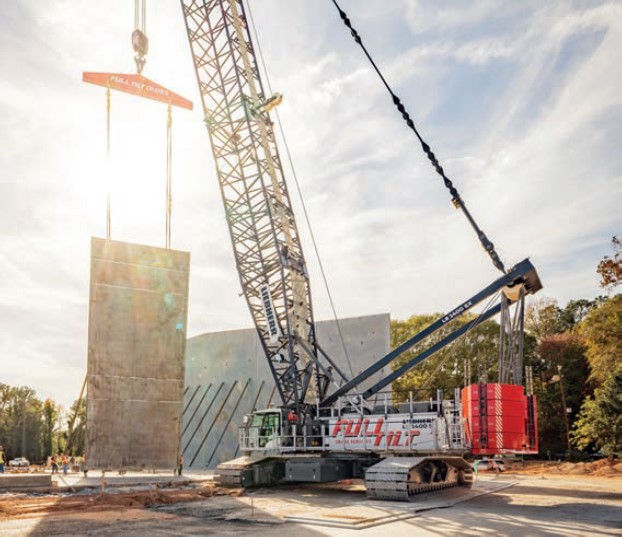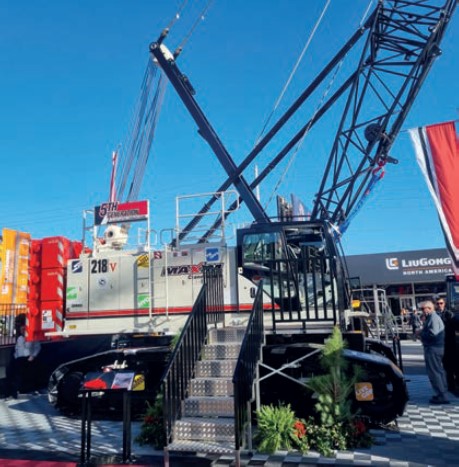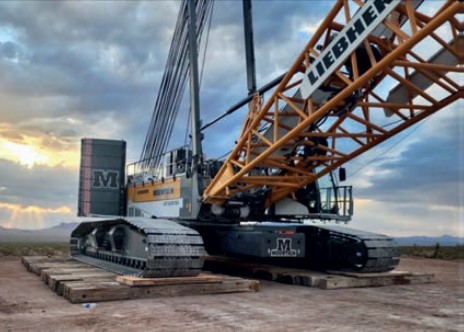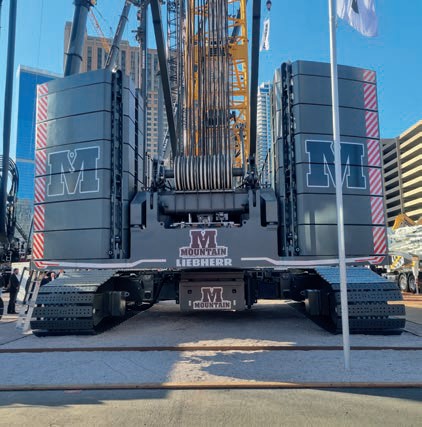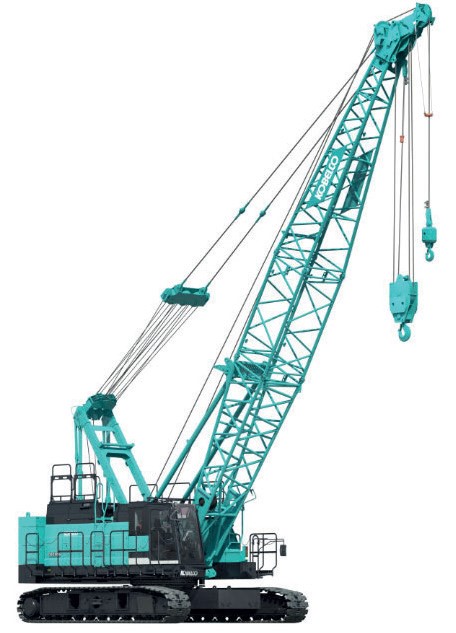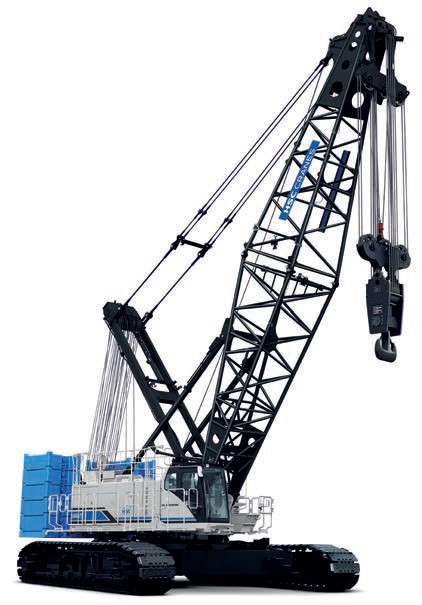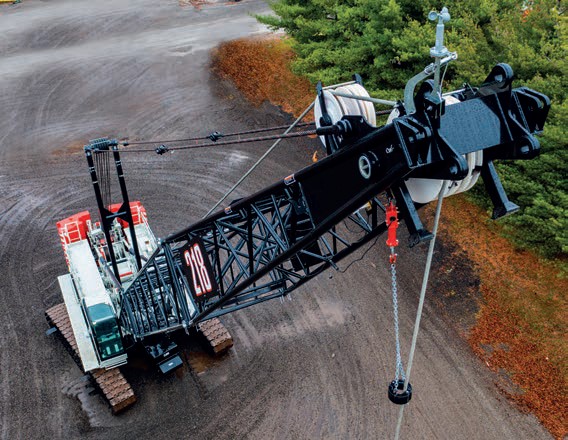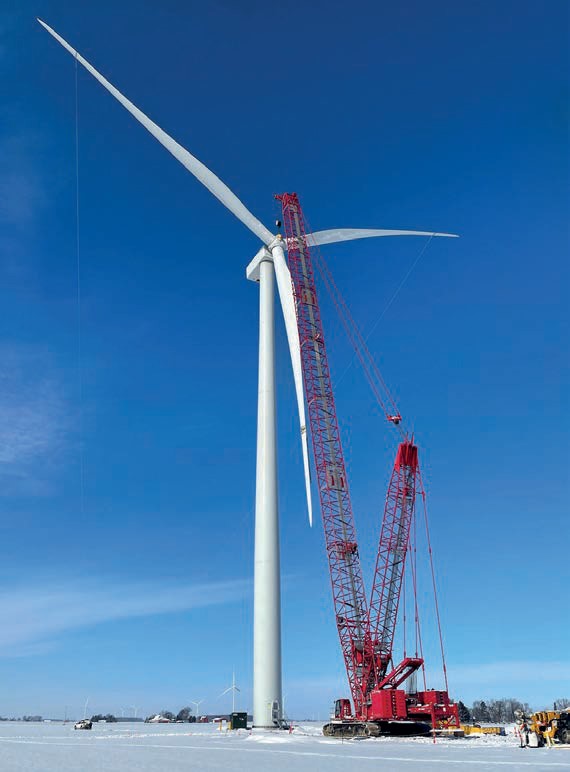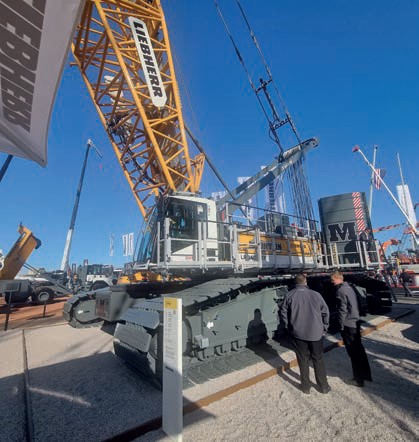Innovation in the middle
26 February 2024The mid-range of the lattice crawler sector offers a balance between lifting power and ease of set up and use. These are workhorse cranes with less complexity than their heavy weight counterparts. Innovation, however, still matters. Will North reports.
Lattice boom crawler cranes have in recent years seen increased competition at both lower and higher capacity classes. On the smaller side, below 100t, these cranes now compete for many jobs with two types of telescopic boom cranes: rough terrains (RT), and telecrawlers. And this rivalry extends up well into the mid-range. Many RTs now exceed 100t capacity, and telecrawlers are offered by Liebherr and Link-Belt with lifting capacities over 200t.
At the higher end large all terrains with capacities up to 1200t offer competition on some jobs. Users like Sarens, BMS, and Mammoet have worked with partners to build their own lattice boom cranes, often able to be powered electrically. And modular lifting equipment —box jacks and jacking towers, for example — can offer a different way to raise heavy loads, without the need for space to assemble a long boom.
But there are a range of medium-to-long-term jobs where these cranes have no rivals. They can work on sites that are not suitable for all terrains, on pre-construction work, where longer on-site travel is expected.
They are typically cheaper where they will be used for longer periods. On major infrastructure and civil projects, like the UK’s HS2, they will be used in large numbers: and this can leave fleets vulnerable to arbitrary political decisions, as seen on this project.
THE WIDENING MIDDLE
Liebherr has traditionally split its crawler manufacturing between two factories: Ehingen, Germany, where heavy lift crawlers are manufactured alongside rough terrains and all terrains; and Nenzing, Austria, where it builds lower capacity crawlers and duty cycle machines – and, historically, dockside cranes.
Until late 2021, that split in function had been demarcated by a clear dividing line: below 300t in Nenzing, above 300t in Ehingen. But with the announcement of the LR 1400 SX in late 2021, this clear distinction was blurred. The new Austrian crane was larger than the smallest crane offered by its German sister factory, and the same capacity as the smallest crawler offered by heavy lift focussed rival Tadano through its former Demag Zweibrucken factory.
The difference between the Nenzing and Ehingen machines wasn’t based on capacity. Instead, it is based on intended application and configurability. The LR 1400 SX offers a much more limited set of configuration options. But it is intended to be easier to set up, for longer term jobs, while having the capacity for heavier lifts close to the crane.
Liebherr showed the 400t capacity crane at ConExpo in 2023, where it proclaimed it as its ‘biggest multipurpose crawler’. In Vegas, it was shown with a 41m (134.5ft) main boom, and a 33m luffing jib.
The crane is designed for easy transport and set up. The crane weighs 46t (51USt), making it easy to ship. Platform and railings remain attached to the uppercarriage during transportation and only need to be folded down. Due to the crane’s self-assembly system, the boom sections, carbody counterweight, crawlers and hoist winches can be easily assembled and disassembled without the need for an auxiliary crane. The crane can hydraulically lift, lower, and secure the 150t rear counterweight without assistance. The rear counterweight is modular and can be equipped with five or ten tonne counterweight slabs, depending on requirements.
A heavy lift crawler, like those built at Ehingen or Zweibrucken, may not need to travel extensively on site. If you have a vessel or module to lift over equipment at a refinery, the benefit of these heavy lift crawlers is that you can pick where to set up, and how to configure the crane, in order to reach over these obstacles, maybe just for one or two lifts.
But cranes like this are more often used over long periods. They might be working on a linear civils project, like a railway or a levee. If a customer wants to build a data centre, delivery warehouse, or battery gigafactory – particularly in the US – the crane might need to move repeatedly to tilt up large concrete panels, to enclose a vast indoor space.
This was one of the first US jobs for the crane, as we’ll see.
The LR 1400 SX is designed with this sort of job in mind. It has four crawler motors, allowing for tight manoeuvres on site. The crane’s track width can be adjusted, allowing for less work on temporary roadways, cutting both financial and carbon costs.
The crane has a couple of key features that support safe on-site travel and set up.
Gradient Travel Aid helps operators navigate slopes safely. The crane’s control system automatically calculates the centre of gravity and warns the operator before the crane leaves the safe area. While travelling, the operator receives information about the permissible and actual gradient and the crane's overall centre of gravity. If necessary, the boom angle can be altered so that the machine remains in the safe area.
While lifting, or preparing to lift, the operator can use Ground Pressure Visualisation. It’s easy to see how this could be a benefit on a big job site in the early stages of construction. The system calculates the current ground pressure of the crane in real time and compares it with the specified safety limits of the relevant position. The ground pressure is displayed in the operator’s cab. This means the operator is permanently aware of whether the machine is situated in, or is approaching, a critical area. The ground pressure of the crane can also be reduced using the ground pressure reduction plates. During lifting work, the operator can lower these plates to significantly increase the crane's ground contact area. The ground pressure under the crane can thus be reduced by more than half. This safety feature is also particularly useful when lifting long booms from the ground.
Another feature that supports safe operation when setting up the crane is Boom Up-and- Down Assistant. When erecting or lowering the boom, this assistance system indicates the approach to the tipping border and automatically stops operation before the operator enters an unsafe zone. The operator no longer has to move the winches of the main boom and luffing jib separately. Controlled folding of the luffing jib begins at the press of a button. The speed of the laying down procedure is controlled with a single joystick. The Boom-Up-and- Down Assistant chooses the safest method for laying down the jib.
WIDER JOB RANGE
All of these features contributed to the selection of the crane for one of its first jobs in the US, lifting tilt-up panels for a studio project in Atlanta, Georgia. The state has pushed itself as a location for filming, offering a 20% tax rebate for shows filmed there – viewers of shows like The Walking Dead will likely recognise the peach logo popping up in end credits.
The developers behind Electric Owl Studios worked with Martin Concrete Construction to build the new facility. They used tilt-up methods, pouring panels as much as 34m high on sites. This drove Full Tilt Crane Services to select the LR 1400 SX.
“We bought the machine to meet the needs of our customers: to lift larger and heavier pieces at one time,” explains managing director Jason Richardson.
The tilt-up panels produced by Full Tilt parent company Martin Concrete Construction on-site have the advantage that it makes them considerably more flexible than precast. This is where the size of the LR 1400 SX plays a significant role. “The sky’s the limit,” says Richardson.
The crane offers Full Tilt advantages beyond just raw capacity. The company often completes jobs in a week or two, before moving on to the next one. “The self-assembly system of the crane is very important to us,” says Richardson. “We don’t need an assist crane. Right now, we can fully assemble our LR 1400 SX in under 12 hours.”
Full Tilt is a specialist, working closely with its parent company. But the first buyers of this crane take on a wider range of jobs. The unit on show at Vegas was sold to Mountain Crane, of Salt Lake City. The company will also use this crane for tilt up work, but also sees opportunities in steel erecting, refineries, power plants, as well as general industrial and construction work. The LR 1400 SX’s first job with Mountain Crane was on a wind farm.
“This is the best machine in its class,” says Paul Belcher, owner and CEO of Mountain Crane. “The LR 1400 SX is an extremely versatile and strong machine that will bring value to Mountain Crane’s fleet.”
The crane has also found customers in the Middle East. Al Jazeera Shipping, based in Bahrain, services the maritime and offshore sectors, with a range of boats and vessels, as well as leasing offshore construction equipment. It has its own 80,000 sq m fabrication yard, in the Mina Salman port area.
Al Jazeera Shipping managing director Ali Hasan Mahmood went shopping for a new crane in 2022 and, after considering his options, selected the LR 1400 SX. One standout feature for a man known as the ‘King of Barges’ was its capability to preselect barge inclinations, which automatically applies the permitted load curve.
Since May 2023 the LR 1400 SX has been working on multiple projects with Bapco at its refinery in Bahrain.
WIDENED BOOM
Users of cranes like this are seeing increased need for larger, multipurpose cranes. That has driven Liebherr Nenzing’s development of the new LR 1400 SX, which shares a design concept, and even some parts, with the LR 1300. But another approach is to increase the capacity of existing multipurpose cranes. And that is what Manitowoc has done with its new wide boom inserts for the MLC 300 VPC MAX.
A crane like this already benefits from the compact footprint made possible by the VPC MAX adjustable counterweight technology. With a wider boom, it can take on higher and heavier jobs, such as some aspects of wind farm work. And it is jobs like this that drove US crane provider Lomma Crane & Rigging to buy the new Wide Boom Plus insert kit.
The updated attachment offers a maximum boom length of 429.8 ft (131m), with a tip height of 452.2 ft with the extended upper boom point. In addition to the longer boom lengths, the extra 30% capacity allows contractors to respond to the trend for taller, heavier wind turbines while continuing to enjoy the benefits of operating smaller cranes.
Lomma partnered with JMS Crane & Rigging to install it on an MLC300 VPC-MAX for maintenance work on multiple wind tower sites across the upper Midwest. “We are excited to have been a part of the kit’s development and now see it at work in the field. It radically expands the use of the MLC300 for renewable energy jobs,” says Steve ‘Burkey’ Burkholder, heavy lift manager at Lomma.
“Now that 89-, 90- and 95-metre towers are becoming more prevalent, we would have to rely on our larger Manitowoc Model 16000 or add a luffing jib to our MLC300 if Manitowoc hadn’t answered our prayers for the Wide Boom Plus kit,” says JMS vice president Rich Johnson. “It also enables a much friendlier crane build, with a smaller footprint, and saves us around 16-20 hours in assembly and disassembly time per job. Given that we might do that 300 times a year, it's a major benefit to us.”
EMISSIONS REGULATIONS
It is rare and notable to see a heavy lift crawler operating in a city centre. But for mid-range multipurpose cranes, work often takes place close to homes, schools and workplaces.
In many cities, mayors and local councils will impose requirements for cranes with newer, lower emissions, engines. And in Europe the regulations for non-road mobile machinery have tightened with the new Stage V rules beginning to take effect in 2019/2020 and a two-year transition period, during which manufacturers could install older engines from their stocks, coming to an end in 2022.
That has driven the development of a range of upgraded cranes, with engines compliant with the new regs.
Kobelco announced three new cranes in its G series in late 2023. These consist of the 100t CKE900G-4, the 150t CKE1350G-4, and the 250t CKE2500G-4. The two larger cranes have been absent from Kobelco’s line up for two years, and will return this year, with their new 270kW Stage V compliant Isuzu engine. The smaller model, the CKE900G-4 builds on the design of the existing CKE900G-3, and has been available since October 2023.
Both the larger cranes feature a new ergonomic cab design. This improves visibility for the operator by removing the crossmember from the front window, giving a clear view from the floor of the cab to the roof. The front wiper motor has also been lowered, removing another obstruction, and increasing the area covered by the wiper.
Other adjustments in the cab are improved air conditioning, and it's now meant to be easier to adjust the seat and lever positions to suit the individual operator.
The G series design includes a number of environmentally friendly ‘G Mode’ functions, which contribute to lower fuel costs and carbon impacts. As well as an auto idle stop function, these include G Winch, which provides high speed without raising engine speed and G Engine, which improves fuel consumption by at least 10%.
HSC Cranes – now a wholly owned subsidiary of Sumitomo, which bought out partner Hitachi’s shares in the business – has also upgraded one of its mid-range cranes, with the third generation of its 275t model: the SCX2800A-3.
This crane is designed using a concept popular in Japan, with a luffing tower – effectively a jib – that allows the crane to work at high and tight radiuses – ideal for construction in constricted city centre job sites.
The main boom extends from 15.25m to 91.45m, and the luffing tower can add 21.35m to 61m to overall system length.
EMISSIONS WATCH
HSC's new crane focusses on emissions. It features a 270kW Stage V Cummins L9 engine, along with Eco winch mode and auto idle stop to reduce fuel use. Safety has also been a focus of the redesign, with a new approach to positioning handrails and improved access.
At the other end of the midrange scale, HSC Cranes’ US subsidiary, Link-Belt Cranes, has been making its own emissions improvements to a long-established model with the launch of the 110USt (100t) 218|V, at ConExpo. The crane traces its design ancestry back more than 35 years.
As well as its new engine the crane offers operators a new 12" touchscreen LMI operating system, plus better visibility with improved sightlines. Ergonomic foot pedals have been moved closer to the cab floor, designed to offer better views of ground level.
The new display has an operator interface with new counterweight sensing for live readout of stacked counterweight, live groundbearing, swing angle indicator, list and trim indicator, engine RPM monitoring, and improved diagnostics.
The operator is assisted by winch-view, back-up, and non-cab side swing-view cameras, with night vision, to enhance jobsite visibility from within the cab.
A new optional lighting package also adds LED light on the cabside upper, below the upper and on the front cab for jobsite settings that require additional early morning or evening cover.
These developments demonstrate that the mid-range lattice crawler sector remains dynamic, with continuous innovation addressing evolving industry needs.
As these cranes become integral to a broader range of projects, their adaptability, efficiency, and environmental considerations will play pivotal roles in shaping the future of this vital segment within the dynamic crane industry.
